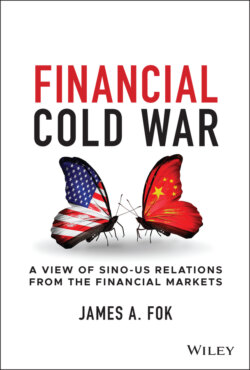Читать книгу Financial Cold War - James A. Fok - Страница 28
Boom and Bust
ОглавлениеIn 1980, Ronald Reagan successfully campaigned for the White House on a promise of smaller government. That promise proved to be empty, as US government deficits ballooned during his presidency. His enormous defence spending eventually exhausted the Soviet Union's ability to keep up, and it imploded amidst the popular dissatisfaction of its own people over the privations to which they had been subjected in the pursuit of dominance over the US. However, amidst the euphoria of the Wall Street boom of the 1980s and America's victorious emergence from the Cold War in the early 1990s, the US and the dollar appeared increasingly unassailable.
Reagan's free market ideology did not mean that his administration took an entirely hands-off approach to the dollar. His presidency witnessed growing domestic paranoia that Japan was poised to surpass the US economically. Following substantial dollar appreciation against other major currencies between 1980 and 1985, US manufacturers campaigned aggressively for government action to protect their export competitiveness. This led to the Plaza Accord in September 1985, under which the US entered into a joint agreement with France, West Germany, Japan and the United Kingdom (UK) to intervene in currency markets to force a depreciation of the dollar against the yen and the Deutschmark. Between 1985 and 1987, the dollar depreciated by around 50 percent against the yen.85
The appreciation in the yen set off a buying spree by Japanese companies overseas. In September 1989, the Sony Corporation bought Columbia Pictures for $3.4 billion in cash, then the largest acquisition in the US by a Japanese company.86 Two months later, Mitsubishi paid $846 million for a 51 percent stake in Manhattan's Rockefeller Centre.87 In what has been seen as a symbol of the excesses of the time, the Imperial Palace grounds in Tokyo were famously estimated to be worth more than all of California. Popular consternation about Japan ‘buying up America’ reached a crescendo. Then the Japanese bubble burst. Since the end of 1989, Japan has fallen into seemingly perpetual economic stagnation.
By the early 1990s, with its major economic challenger in decline and its major military and geopolitical rival collapsing, the US was at the zenith of its power. Even as new challenges began to mount up in subsequent decades, however, the dollar has gone from strength to strength.
The framework put in place by Harry White at Bretton Woods put the dollar at the heart of the global monetary system. Policies pursued by successive US administrations after WW2 enabled the widespread adoption of the dollar as the dominant currency for international capital raising and investment. Financial institutions, notably in the City of London, grasped the commercial opportunity that this offered, supported by local governments and regulators. As capital market flows came to far outstrip commercial trade flows and global payments and market infrastructure developed around the dollar-based system, the dollar's position in the global monetary order became more entrenched. By the time that President Nixon severed the dollar's tie to gold, there was no credible alternative to take its place.
Paradoxically, the very undermining of the dollar's value caused by that decision enabled the US currency's international reach to widen further. This is because it freed the US from residual constraints on its balance of payments deficits, and the volatility it unleashed in financial markets precipitated the development and proliferation of derivatives. The US dollar is now not only the reference currency in which individuals and corporations all over the world conduct commerce and account for their asset holdings, but it has also become the reference currency in which they manage their financial risks. The global payments and settlement infrastructures created in the 1960s and 1970s enabled and accelerated this process, as they facilitated secure and cost-efficient cross-border financial trading and, more importantly over time, the mobilisation of vast pools of securities as collateral around the globe.
Given how entrenched it has become, it is difficult to see how the dollar could be displaced. However, the dollar's success has generated significant challenges for other countries and has created enormous burdens for the US itself. International holdings of US financial assets, particularly Treasury securities held by foreign governments, have saddled the US with weighty international obligations. The reduced currency flexibility that the US is locked into by Triffin's dilemma has also contributed to wage stagnation and unemployment domestically. Notwithstanding the exorbitant privilege that the dollar has conferred upon the US, therefore, it might be asked whether it is the rest of the world or America that has borne the higher cost.
